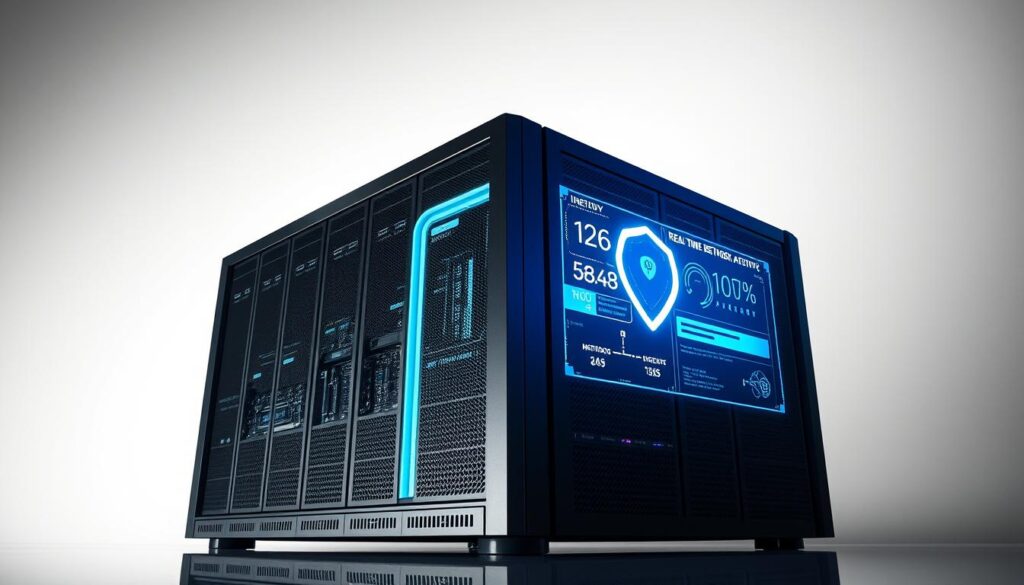
Firewall Protection: Safeguard Your Digital Life
In today’s digital age, firewall protection plays a crucial role in ensuring network security and cybersecurity. A firewall acts as a barrier between a trusted network and an untrusted network, such as the internet, to prevent unauthorized access and malicious activities. By implementing effective firewall protection, individuals and organizations can significantly reduce the risk of cyber threats and protect their digital assets.
Firewall protection is essential for safeguarding digital life, as it helps to prevent cyber attacks and data breaches. By controlling incoming and outgoing network traffic, firewalls can block malicious activities and prevent unauthorized access to sensitive information. This is particularly important in the context of cybersecurity, where the threat of cyber attacks is constantly evolving.
Effective firewall protection is critical for maintaining network security and preventing cyber threats. By understanding the importance of firewall protection, individuals and organizations can take steps to implement robust security measures and protect their digital assets. This includes staying up-to-date with the latest cybersecurity threats and implementing best practices for firewall configuration and management.
Introduction to Firewall Protection
Key Takeaways
- Firewall protection is essential for network security and cybersecurity
- Firewalls act as a barrier between trusted and untrusted networks
- Effective firewall protection can prevent cyber attacks and data breaches
- Firewall configuration and management are critical for maintaining network security
- Staying up-to-date with the latest cybersecurity threats is essential for effective firewall protection
Understanding the Fundamentals of Firewall Protection
Firewall protection is a crucial aspect of digital security, and understanding its fundamentals is essential for safeguarding your online presence. At its core, a firewall is a network security system that monitors and controls incoming and outgoing network traffic based on predetermined security rules. Firewall software and firewall solutions are designed to prevent unauthorized access to your digital assets, protecting you from various cyber threats.
When it comes to protecting your digital assets, firewalls play a vital role in preventing malicious activities such as hacking, malware, and denial-of-service (DoS) attacks. By installing firewall software or implementing firewall solutions, you can significantly reduce the risk of cyber threats and ensure the security of your online data.
Some common types of cyber threats that firewalls can prevent include:
- Malware and viruses
- Hacking and unauthorized access
- Denial-of-service (DoS) attacks
- Phishing and spamming
By understanding the fundamentals of firewall protection and implementing effective firewall solutions, you can ensure the security and integrity of your digital assets, protecting yourself from various cyber threats and maintaining a safe online presence.
The Evolution of Firewall Technology
Firewall technology has undergone significant transformations over the years, adapting to emerging threats and the increasing complexity of network environments. From basic packet filtering to advanced next-generation firewalls, this evolution has been driven by the need for more effective and efficient network security solutions. The development of firewall technology has enabled organizations to protect their digital assets from various types of cyber threats, including malware, phishing, and denial-of-service attacks.
The advancements in firewall technology have led to the creation of more sophisticated and robust security systems. For instance, next-generation firewalls offer enhanced features such as deep packet inspection, intrusion prevention, and application control. These features enable firewalls to detect and prevent advanced threats, including zero-day exploits and targeted attacks. The integration of artificial intelligence and machine learning into firewall technology has further improved its capabilities, enabling it to detect and respond to threats in real-time.
- Improved packet inspection and filtering capabilities
- Enhanced intrusion detection and prevention systems
- Increased support for virtual and cloud-based environments
- Integration with other security solutions, such as antivirus and VPNs
These advancements have enabled firewalls to become a critical component of modern network security architectures, providing organizations with a robust defense against cyber threats. As firewall technology continues to evolve, it is likely to play an even more important role in protecting digital assets and preventing cyber attacks.
Different Types of Firewalls for Various Needs
When it comes to protecting your digital assets, having the right type of firewall is crucial. With various options available, it’s essential to understand the advantages and disadvantages of each to make an informed decision. Effective firewall management is key to ensuring your digital security.
Firewall services can be categorized into several types, each designed to meet specific needs. These include:
- Hardware firewalls, which are physical devices installed between your network and the internet
- Software firewalls, which are programs installed on your computer or device
- Cloud-based firewall solutions, which provide protection through cloud-based services
- Next-generation firewalls, which offer advanced security features and threat detection
By understanding the different types of firewalls and their respective firewall services, you can choose the one that best suits your needs, whether for personal use or business applications. This will help ensure your digital assets are protected and your online activities are secure.
Essential Features of Modern Firewall Protection
When it comes to protecting your digital assets, following best firewall practices is crucial. A modern firewall should have essential features such as intrusion detection and prevention systems, virtual private network (VPN) support, and advanced threat protection. These features work together to provide a robust defense against evolving cyber threats.
Some of the key features to look for in a modern firewall include:
- Intrusion detection and prevention systems to identify and block malicious traffic
- Virtual private network (VPN) support to secure remote connections
- Advanced threat protection to detect and prevent sophisticated attacks
By following best firewall practices and implementing these essential features, you can significantly enhance the security and efficiency of your firewall. 
It’s also important to regularly review and update your firewall settings to ensure you’re getting the most out of your security system. By staying informed and taking a proactive approach to firewall management, you can help protect your digital assets from cyber threats and ensure long-term security.
Setting Up Your First Firewall
When it comes to protecting your digital assets, a well-implemented firewall is essential. The process of firewall implementation can seem daunting, but with the right guidance, you can ensure your network is secure. To start, it’s crucial to understand the importance of proper configuration. A poorly configured firewall can leave your system vulnerable to cyber threats, making it essential to follow best practices.
A key aspect of firewall implementation is understanding the different types of firewalls available. This knowledge will help you make an informed decision when choosing a firewall that suits your needs. By considering factors such as network size and complexity, you can select a firewall that provides the necessary level of protection.
- Choosing a reputable firewall provider
- Configuring the firewall to block unnecessary ports and protocols
- Regularly updating the firewall software to ensure you have the latest security patches
By following these guidelines and taking a proactive approach to firewall implementation, you can significantly reduce the risk of cyber threats and protect your digital assets.
Common Firewall Vulnerabilities and How to Address Them
Firewalls play a crucial role in network security, protecting against various types of cyber threats. However, like any other security system, firewalls can have vulnerabilities that compromise their effectiveness. Outdated firmware, weak passwords, and misconfigured settings are common vulnerabilities that can be exploited by hackers.
To strengthen your firewall’s security posture, it’s essential to regularly update your firmware and use strong, unique passwords. Additionally, ensuring that your firewall settings are properly configured can help prevent unauthorized access to your cybersecurity system.
Some common firewall vulnerabilities include:
- Outdated firmware
- Weak passwords
- Misconfigured settings
By being aware of these potential weaknesses and taking proactive steps to address them, you can significantly enhance your network security and protect your digital assets from cyber threats.

Advanced Firewall Configuration Strategies
When it comes to protecting complex network environments, advanced firewall configuration strategies are essential. This involves optimizing firewall settings to meet the specific needs of the network architecture. Effective firewall management is critical to ensuring the security and integrity of the network.
A key aspect of advanced firewall configuration is rule creation and management. This involves defining rules that govern incoming and outgoing network traffic, based on factors such as source and destination IP addresses, ports, and protocols. By carefully managing these rules, network administrators can prevent unauthorized access to the network and protect against cyber threats.
Optimizing Firewall Settings
To optimize firewall settings, network administrators can use firewall services such as traffic monitoring and security policies. These services provide real-time visibility into network traffic, allowing administrators to identify and respond to potential security threats. By implementing these strategies, organizations can ensure the security and integrity of their network environments.
Best Practices for Advanced Firewall Configuration
Some best practices for advanced firewall configuration include:
- Regularly reviewing and updating firewall rules
- Implementing traffic monitoring and security policies
- Using firewall services to optimize firewall settings
Integrating Firewalls with Other Security Measures
To create a robust cybersecurity framework, it’s essential to integrate firewall solutions with other security measures. This approach ensures that your digital assets are protected from various types of cyber threats. By combining firewalls with antivirus software, VPNs, and intrusion detection systems, you can significantly enhance your overall cybersecurity posture.
A comprehensive security strategy that includes firewalls can provide multi-layered protection against a wide range of threats. This means that even if one security measure is breached, others can still prevent malicious activity. For instance, antivirus software can detect and remove malware, while a VPN can encrypt internet traffic, making it difficult for hackers to intercept sensitive data.
Some key benefits of integrating firewalls with other security measures include:
- Improved threat detection and prevention
- Enhanced security for remote workers and cloud-based assets
- Simplified security management and monitoring
By adopting a layered security approach that includes firewall solutions and other security measures, individuals and organizations can significantly reduce the risk of cyber attacks and protect their digital assets.
Business Applications of Firewall Protection
Firewall protection is essential for businesses to safeguard their sensitive data and ensure network security. By implementing a robust firewall system, companies can protect themselves from cyber threats and prevent financial loss. Network security is a top priority for businesses, and firewall protection is a critical component of this effort.
Some of the key business applications of firewall protection include:
- Protecting sensitive data from unauthorized access
- Preventing malware and virus attacks
- Blocking unauthorized access to the network
- Ensuring compliance with security regulations
By investing in firewall protection, businesses can ensure the continuity of their operations and protect their reputation. It is essential for companies to regularly update and maintain their firewall systems to stay ahead of emerging cyber threats and ensure the security of their network.
Maintaining and Updating Your Firewall
Proper firewall implementation is crucial for ensuring the security of your digital assets. To keep your firewall effective, it’s essential to perform regular maintenance tasks. This includes reviewing configuration settings, updating software, and monitoring performance. By following best firewall practices, you can help prevent cyber threats and protect your sensitive information.
Regular maintenance tasks should be performed on a schedule to ensure your firewall remains up-to-date. This can include tasks such as:
- Updating firewall software and firmware
- Reviewing and updating configuration settings
- Monitoring firewall performance and logs
By staying on top of these tasks, you can help ensure your firewall continues to provide optimal protection for your digital assets.
It’s also important to follow best firewall practices when it comes to update procedures. This includes testing updates before implementing them and ensuring that all updates are compatible with your existing configuration. By taking a proactive approach to firewall maintenance and updates, you can help ensure the long-term security of your digital assets.
Conclusion: Ensuring Long-term Digital Security through Effective Firewall Management
As we conclude this comprehensive guide on firewall technology and cybersecurity, it’s clear that a robust firewall is the cornerstone of effective digital protection. By understanding the fundamental principles of firewalls, exploring the various types available, and mastering advanced configuration strategies, you can fortify your digital defenses and safeguard your online assets for the long term.
Maintaining and regularly updating your firewall is crucial in the ever-evolving landscape of cyber threats. Diligent maintenance, including monitoring performance and applying the latest security patches, ensures your network remains impenetrable against emerging attacks. Remember, complacency is the enemy of digital security – staying vigilant and proactive is the key to weathering the storm of cybercrime.
As you embark on your journey to enhance your digital security, embrace the power of firewall technology and make it an integral part of your comprehensive cybersecurity strategy. With the knowledge and tools provided in this article, you are well-equipped to navigate the complexities of firewall management and ensure the long-term protection of your digital life.
FAQ
What is a firewall and how does it protect my digital assets?
A firewall is a security system that monitors and controls the incoming and outgoing network traffic based on predetermined security rules. It acts as a barrier between a trusted network, such as your home or office, and an untrusted network, like the internet, to prevent unauthorized access and block malicious activities.
What types of cyber threats can a firewall prevent?
Firewalls can protect against a wide range of cyber threats, including unauthorized access attempts, malware infections, distributed denial-of-service (DDoS) attacks, and other malicious activities. They help safeguard your digital assets, such as sensitive data, network resources, and connected devices, from potential harm.
What are the different types of firewalls available?
There are several types of firewalls, including hardware firewalls, software firewalls, cloud-based firewall solutions, and next-generation firewalls. Each type has its own advantages and is suitable for different needs, ranging from personal use to enterprise-level network security.
What are the essential features of modern firewall protection?
Modern firewalls often include features such as intrusion detection and prevention systems, virtual private network (VPN) support, advanced threat protection, and the ability to enforce security policies. These features work together to provide comprehensive network security and protect against evolving cyber threats.
How do I set up my first firewall?
Setting up your first firewall involves following best practices for installation, configuration, and testing. This includes properly configuring firewall rules, enabling necessary security features, and regularly updating the firewall software to ensure optimal protection.
How can I address common firewall vulnerabilities?
Common firewall vulnerabilities can include outdated firmware, weak passwords, and misconfigured settings. To address these, it’s important to keep your firewall software up-to-date, use strong authentication methods, and regularly review and optimize your firewall configuration.
How can I integrate my firewall with other security measures?
Firewalls can be integrated with other security solutions, such as antivirus software, virtual private networks (VPNs), and intrusion detection systems. This layered approach provides enhanced protection by combining the strengths of different security technologies to defend against a wide range of cyber threats.
How do I maintain and update my firewall for long-term security?
Maintaining and updating your firewall is crucial for ensuring its continued effectiveness. This includes regularly performing maintenance tasks, applying software updates, and monitoring firewall performance to identify and address any issues that may arise over time.